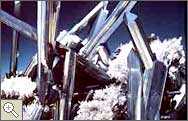|
|
 |
 |
 |
|
Getting Started |
 |
 |
 |
 |

Standards:
This lesson matches Mid-Continent Regional Educational Laboratory (McREL) educational standards.
Grades:3-8
Subjects:
Science
Geology
Technology
In the game Twenty Questions, the first thing you ask is "Is it animal, vegetable, or mineral?" Well, it's a good question, because anything that didn't come from a plant or an animal probably came from a mineral. The bricks of your school building, the glass in your windows, the chalk you teach with- none would exist without minerals. Minerals are also essential in science and industry, for everything from computer circuits to diamond drills. Apart from their utility, beautiful and precious gems cut from mineral crystals give us pleasure to wear or just look at. Minerals are our most valuable and widely used natural commodities.
The goal of this issue of Smithsonian in Your Classroom is in part to introduce students to the basics of mineral science, but also to teach the scientific process by instructing students how to observe, form hypotheses, and draw conclusions. Minerals are an ideal subject for this because they are readily available, they are intrinsic to daily life, and they appeal to students. By using minerals as a stepping-stone to learning the scientific process, students will find that science is not the sole domain of adults in lab coats, but an exciting process in which they can make their own discoveries.
This issue of Smithsonian in Your Classroom will also introduce you and your students to specimens from the Janet Annenberg Hooker Hall of Geology, Gems, and Minerals. Visit the exhibition at the National Museum of Natural History in Washington, D.C.
|
 |
 |
 |
 |

These stibnite crystals have a metallic luster.
|
 |
 |

Stibnite © Smithsonian Institution
|
 |
 |
 |
|


|
|
|

